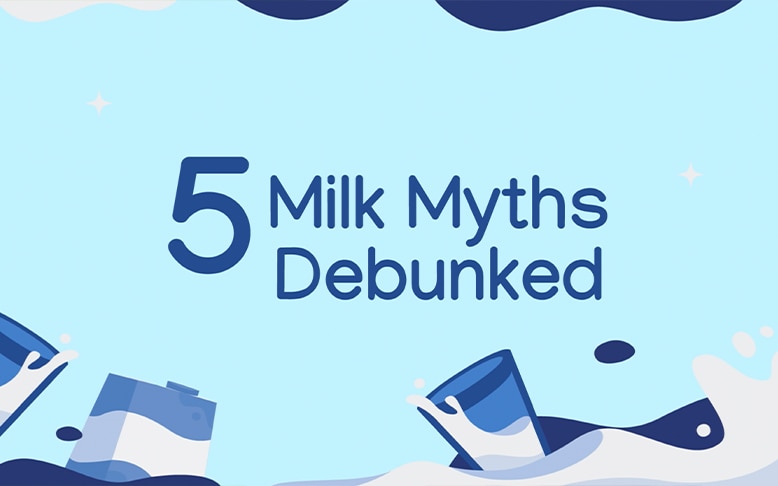What is Milk?
Nutritious and important are the two default words we often hear associated with milk. Milk is coined as a complete food by containing carbohydrates, protein, fat, vitamins, and minerals required by the body. The 10 Nutritional Guidelines of Filipinos promotes consumption of milk and milk products for healthy bones and teeth1. But what is it really loaded with? What more can a glass of milk offer?

Figure 1. Nutrient Benefits of a Glass of Milk
Emerging Benefits of Milk
More than providing nutrients for strong bones and teeth, milk drinking is found to offer other health benefits. Over the years, researchers have been studying the beneficial effects of milk in the prevention of some lifestyle diseases.

Bank Account for your Calcium: Your Bones
Bones can be likened to a bank account. As the body develops, the bones save calcium. During younger years, drinking milk ensures that the body is provided with the calcium it needs to help bones reach their full mass density potential. When the body grows older, calcium absorption decreases10 and all those deposits from younger years will gradually be used up. Without proper intervention, all the stored calcium will be depleted, which can lead to bone problems.
Aside from calcium, exercise is important to building healthy bones. Exercise triggers nerve impulses that, in turn, activate body chemicals to deposit calcium in our bones. Regular walking, dancing, kickboxing and strength training are good examples of these types of activities.
Milk Types and Nutrient Content
You might have heard of the kinds of milk, but what exactly are they? How do the various forms of milk differ?
Cow’s milk is generally offered in several varieties. These are whole milk, low fat milk and non-fat/skimmed milk. They differ in fat and calorie content but have relatively similar protein and calcium delivery. Take a look at the nutrient content of each kind below.
| Nutrients | Per 100ml | ||
|---|---|---|---|
| Whole milk or full cream | Low fat | Non-fat or skimmed milk | |
| Fat (g) | 3.52 | 1.48 | 0.4 |
| Energy (kcal) | 64 | 47 | 36 |
| Protein (g) | 3.52 | 3.52 | 3.6 |
| Calcium (mg) | 125.2 | 129.6 | 132 |
Based on NESTLÉ Fresh Milk, NESTLÉ Low fat Milk and NESTLÉ Non-fat Milk nutrient declaration
Milk and Weight Loss: What’s the good news?
Studies have shown milk helps in weight loss8. It was seen that those who had three to four servings of milk or milk products lost significant weight more than those who also cut calories but drank little to no milk. In fact, the research indicates that including milk when dieting can help people lose more weight in the abdominal area and help them maintain muscle.
Aside from that, many recent studies have shown that dairy products may help promote healthy weight or prevent an unhealthy weight gain among children and adolescents. Some research has shown that a higher intake of dairy foods is associated with a lower percentage of body fat among children and teenagers.
FAQs (on Milk, Weight Management, and more)
Q: How can milk help me lose weight?
A: Calcium prevents the parathyroid hormone from stimulating the production and storage of fat cells. Also, calcium binds with fatty acids in the small intestines preventing fat absorption.
Q: All I have to do is start drinking milk and I'll lose weight?
A: The most effective way to lose weight is to reduce the intake of high calorie foods and increase physical activity. And the best approach is still to slowly but steadily – lose about one to two pounds a week.
Regardless of the diet, nonfat milk can help the effectiveness of weight loss efforts because the calcium and other nutrients in milk help burn more fat8.
Q: How does milk help me burn fat?
A: Researchers believe diets that include milk increases fat breakdown and suppresses a hormone that results in reduced fat accumulation11. When you don't drink milk and there isn't much calcium in your diet, the fat cells receive a signal to conserve fat.
Q: Why do older women need to drink milk?
A: Postmenopausal osteoporosis (or Type 1 osteoporosis) occurs only in women between the ages of 50 to 70 years. It results from accelerated bone loss largely as a result of estrogen deficiency. There is increased bone turnover, gradual loss of bone mass, microarchitecture, structure and strength leading to an overall lower bone quality and risk of osteoporosis.
While bone gain and loss is a natural phenomenon, scientific evidence shows that good nutritional and lifestyle habits can slow down the process and help maintain healthy bones throughout life.
Q: Is organic milk better?
A: There is no difference in nutrient composition between organic and regular milk. Both milks are pure, natural and safe. Organic statements refer to the practices of the farm, not to the quality of the product. Whether the consumer chooses organic or regular milk, they will receive a nutrient-rich and healthy product.
Q: What about calcium supplements and calcium fortified foods?
A: While they may fill the calcium gap, they don’t supply the other important nutrients found naturally in milk. Too much calcium from supplements and fortified foods may limit the absorption of iron and zinc which are equally vital to our body processes.
Q: What is Lactose Intolerance?
A: Lactose is a natural sugar in milk and milk products. During digestion, lactase, an intestinal enzyme, breaks down lactose into smaller, more easily digested sugars. When a person’s body produces too little lactase to adequately digest the amount of lactose in foods, the person is said to be “lactose intolerant”.
When the lactose is not digested, it is fermented by the good bacteria in the intestinal tract. This fermentation produces uncomfortable symptoms like nausea, cramps, bloating, gas, diarrhea and abdominal pain. However, people with lactose intolerance can still benefit from all the nutrients of milk.
Q: How can you manage lactose intolerance?
A: Lactose intolerance is easy to manage. Most people with lower levels of lactase can drink a cup of milk without discomfort and can include some dairy and other lactose-containing foods in their meals and snacks. Try these tips to manage lactose intolerance.
- Find out your tolerance level. Experiment by taking in small amounts of lactose-containing foods. Then gradually increase the portion size to determine your tolerance level.
- Combine lactose-containing foods as part of a meal or a snack, rather than eating it alone. It is a way of diluting the lactose. For example, try a milk-fruit smoothie combination. The mix of foods slows down the release of lactose into the digestive system, making it easier to digest.
- Eat smaller but more frequent portions of lactose-rich foods. Drink ½ cup servings of milk several times throughout the day instead of 1-cup servings.
- Try yogurt made with active cultures. They’re easier to digest because their “friendly” bacteria help digest the lactose. Not all cultured dairy foods contain live cultures. Look for the Live Microorganism seal which ensures that the brand you are buying contains live microorganisms.
- Choose whole-milk dairy products. The higher fat content of whole-milk dairy products may help to slow down the rate of digestion, allowing a gradual release of lactose. Then in order not to have too much fat in your diet, choose other foods with less fat.
- Go for other calcium-rich foods such as: dark-green leafy vegetables, broccoli and other greens; canned sardines and salmon with bones. For canned fish, the calcium is in the bones.
Milk Group of the Food Pyramid: Milk, Yogurt, and Cheese
All foods made from milk—yogurt, cheese, cottage cheese, buttermilk, frozen yogurt, and ice cream—as well as pudding and milkshakes are part of the Milk Group. In general, 1 cup of milk or yogurt, 1 ½ ounces of natural cheese, or 2 ounces of processed cheese can be considered as 1 cup from the milk group.
However, a few dairy foods don’t belong in the Milk group, like butter, cream cheese, and sour cream. These are made from the cream that naturally separates from unhomogenized milk. They are grouped with fats, oils and sweets in the top of the Food Guide Pyramid because they are high in fat; and contribute only small amounts of minerals and vitamins and protein to the diet.
More ways to include calcium-rich Milk Group foods in meals and snacks
Now that you’ve seen the many benefits of milk and milk group products in your diet, these are some ways you can purposefully include them in your meals and snacks without feeling that you’re having too much milk.
- Include milk as a beverage at meals. Choose fat-free or low-fat milk like Nesvita ProHeart.
- If you usually drink whole milk, switch gradually to fat-free milk.
- For a change of pace, try flavored milk (chocolate, strawberry, melon, banana or other flavors) whichever you prefer.
- Add fat-free or low-fat milk instead of water to oatmeal and hot cereals.
- Use fat-free or low-fat milk when making condensed cream soups (such as cream of tomato).
- Have fat-free or low-fat yogurt as a snack. Try Nestle fruit selection yogurt.
- Make a dip for fruits or vegetables from yogurt.
- Make fruit-yogurt smoothies in the blender.
- For dessert, make chocolate or butterscotch pudding with fat-free or low-fat milk.
- Top cut-up fruit with flavored yogurt for a quick dessert.
- Top soups or salads with shredded low-fat cheese.
- Top a baked potato with fat-free or low-fat yogurt.
- Use plain, low-fat, or fat-free yogurt or cottage cheese (processed in a blender) in recipes as a substitute for sour cream.
- Start your day with yogurt or a yogurt-fruit smoothie with breakfast.
- Try cottage cheese with tomato slices and sardines as a side dish.
So when you feel like skipping your milk or milk food group item for the day, remember what important nutrients it is packed with and the role that it plays in your health. If you haven’t included it in your diet, it is not too late to start today!
As milk is a crucial component in good nutrition, Filipinos need affordable and nutritious milk. Know more about BEAR BRAND and its benefits through this link.
Goodness of Milk Infographic



 Nestlé
Nestlé















No comments here yet.